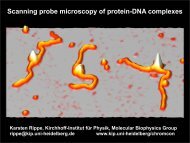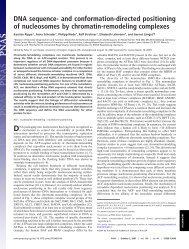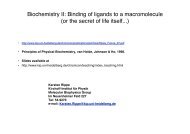Human ISWI chromatin-remodeling complexes sample ...
Human ISWI chromatin-remodeling complexes sample ...
Human ISWI chromatin-remodeling complexes sample ...
You also want an ePaper? Increase the reach of your titles
YUMPU automatically turns print PDFs into web optimized ePapers that Google loves.
esults of several reports that demonstrate a connection between<br />
<strong>remodeling</strong> activity and histone modifications as reviewed in ref. 7.<br />
From the parameters measured here for the isolated Snf2H ATPase<br />
and its complex with Acf1 (endogenous protein concentration 0.15–<br />
0.83 μM, average residence time 75–430 ms) we estimate that<br />
nucleosomes are <strong>sample</strong>d at a rate of 0.1–3min −1 by a specific<strong>ISWI</strong>type<br />
complex. To probe 99% of all genomic nucleosomes, average<br />
sampling times of ∼80 s (all Snf2H containing remodelers) and ∼45<br />
min (ACF) are calculated with the values from the FRAP analysis (SI<br />
Materials and Methods and Table S2). These results have to be<br />
regarded as upper limits because the average residence times in the<br />
order of 10 ms from the FCS analysis would decrease the corresponding<br />
sampling times to 11–64 s. Thus, after setting an appropriate<br />
signal a nucleosome can be translocated within tens of seconds<br />
or minutes to its new position. For this mechanism a relatively large<br />
concentration of remodelers is required to <strong>sample</strong> the ensemble of<br />
all nucleosomes in the genome at an acceptable speed. If the cell<br />
contained a 100-fold lower concentration of <strong>ISWI</strong>-type remodelers,<br />
i.e., a concentration of a few nanomolar, the sampling time would<br />
increase to hours. This would introduce a significant lag time for the<br />
readout of external signals on the timescale of cellular transitions.<br />
From this point of view a large pool of remodelers with only a small<br />
fraction of simultaneously active <strong>complexes</strong> seems mandatory to<br />
respond quickly to changes of the <strong>chromatin</strong> state. It is noted that<br />
these features of the continuous sampling mechanism are in excellent<br />
agreement with findings on cyclically occurring epigenetic processes<br />
that initiate and terminate <strong>remodeling</strong> of <strong>chromatin</strong> by SWI/<br />
SNF and NuRD <strong>complexes</strong> (33, 43, 44). In contrast, a large fraction<br />
of continuously active remodelers would constantly expose all parts<br />
of the DNA sequence to the surrounding nucleoplasm at much<br />
higher energy costs, because the remodelers’ ATPase activity is<br />
stimulated by the bound nucleosome substrate (32). Thus, our<br />
findings point to a tight regulation of <strong>chromatin</strong> accessibility, realized<br />
by nucleosomes as switches that are continuously <strong>sample</strong>d by <strong>chromatin</strong><br />
remodelers and triggered upon distinct signals.<br />
Materials and Methods<br />
Experiments were conducted with GFP and RFP constructs of human Snf2H,<br />
Snf2L, Snf2L+13, and Acf1 in human U2OS osteosarcoma, human embryonic<br />
kidney HEK293T, and mouse NIH 3T3 cell lines as described in SI Materials and<br />
Methods. For Snf2H-GFP, GFP-Snf2L, and GFP-Snf2L+13 stably transfected U2OS<br />
clones were derived. Other constructs were introduced via transient transfection.<br />
FRAP, CP, and F(C)CS experiments were conducted as described previously<br />
(19) and in SI Materials and Methods.Atleast20cellsweremeasuredfor<br />
a given experimental condition. For FRAP the time evolution of the intensity<br />
integrated over the bleach spot was fitted to a diffusion model, to a binding<br />
model, or to a reaction–diffusion model that incorporates both diffusion and<br />
binding processes. In the CP experiments the decay of the fluorescence signal<br />
due to the dynamic equilibrium of photobleaching, diffusion, and <strong>chromatin</strong><br />
dissociation/association of GFP-tagged proteins was used to measure the<br />
immobilized fraction with the resolution given by the confocal excitation volume.<br />
The FCS data were fitted to a one- or two-component anomalous diffusion<br />
model, which is characterized by a nonlinear time dependency of the mean<br />
squared particle displacement given by the anomaly parameter α.<br />
ACKNOWLEDGMENTS. We thank Malte Wachsmuth for help and discussions,<br />
Patrick Varga-Weisz (Babraham Institute, Cambridge, UK) and David<br />
Picketts (Ottawa Health Research Institute, Ottawa, Canada) for plasmid<br />
vectors, and Hanswalter Zentgraf (Deutsches Krebsforschungszentrum,<br />
Heidelberg, Germany) for the Snf2L+13 antibody. This work was supported<br />
by Deutsche Forschungsgemeinschaft Grants Ri 1283/8-1 (to K.R.) and FOR1068<br />
(to G.L.) and by the Baygene program of the Bavarian State Ministry of<br />
Sciences, Research, and the Arts (G.L.).<br />
1. Radman-Livaja M, Rando OJ (2010) Nucleosome positioning: How is it established, and<br />
why does it matter Dev Biol 339:258–266.<br />
2. Jiang C, Pugh BF (2009) Nucleosome positioning and gene regulation: Advances<br />
through genomics. Nat Rev Genet 10:161–172.<br />
3. Segal E, Widom J (2009) From DNA sequence to transcriptional behaviour: A<br />
quantitative approach. Nat Rev Genet 10:443–456.<br />
4. Henikoff S (2008) Nucleosome destabilization in the epigenetic regulation of gene<br />
expression. Nat Rev Genet 9:15–26.<br />
5. Flaus A, Martin DM, Barton GJ, Owen-Hughes T (2006) Identification of multiple distinct<br />
Snf2 subfamilies with conserved structural motifs. Nucleic Acids Res 34:2887–2905.<br />
6. Rippe K, et al. (2007) DNA sequence- and conformation-directed positioning of nucleosomes<br />
by <strong>chromatin</strong>-<strong>remodeling</strong> <strong>complexes</strong>. Proc Natl Acad Sci USA 104:15635–15640.<br />
7. Gangaraju VK, Bartholomew B (2007) Mechanisms of ATP dependent <strong>chromatin</strong><br />
<strong>remodeling</strong>. Mutat Res 618:3–17.<br />
8. He X, Fan HY, Garlick JD, Kingston RE (2008) Diverse regulation of SNF2h <strong>chromatin</strong><br />
<strong>remodeling</strong> by noncatalytic subunits. Biochemistry 47:7025–7033.<br />
9. Corona DF, Tamkun JW (2004) Multiple roles for <strong>ISWI</strong> in transcription, chromosome<br />
organization and DNA replication. Biochim Biophys Acta 1677:113–119.<br />
10. Bork P, Koonin EV (1993) An expanding family of helicases within the ‘DEAD/H’<br />
superfamily. Nucleic Acids Res 21:751–752.<br />
11. Eisen JA, Sweder KS, Hanawalt PC (1995) Evolution of the SNF2 family of proteins:<br />
Subfamilies with distinct sequences and functions. Nucleic Acids Res 23:2715–2723.<br />
12. Boyer LA, Latek RR, Peterson CL (2004) The SANT domain: A unique histone-tailbinding<br />
module Nat Rev Mol Cell Biol 5:158–163.<br />
13. Grüne T, et al. (2003) Crystal structure and functional analysis of a nucleosome<br />
recognition module of the <strong>remodeling</strong> factor <strong>ISWI</strong>. Mol Cell 12:449–460.<br />
14. Eberharter A, Becker PB (2004) ATP-dependent nucleosome remodelling: Factors and<br />
functions. J Cell Sci 117:3707–3711.<br />
15. Banting GS, et al. (2005) CECR2, a protein involved in neurulation, forms a novel<br />
<strong>chromatin</strong> <strong>remodeling</strong> complex with SNF2L. Hum Mol Genet 14:513–524.<br />
16. Längst G, Becker PB (2001) Nucleosome mobilization and positioning by <strong>ISWI</strong>containing<br />
<strong>chromatin</strong>-<strong>remodeling</strong> factors. J Cell Sci 114:2561–2568.<br />
17. Narlikar GJ, Fan HY, Kingston RE (2002) Cooperation between <strong>complexes</strong> that<br />
regulate <strong>chromatin</strong> structure and transcription. Cell 108:475–487.<br />
18. Wachsmuth M, Caudron-Herger M, Rippe K (2008) Genome organization: Balancing<br />
stability and plasticity. Biochim Biophys Acta 1783:2061–2079.<br />
19. Müller KP, et al. (2009) Multiscale analysis of dynamics and interactions of hetero<strong>chromatin</strong><br />
protein 1 by fluorescence fluctuation microscopy. Biophys J 97:2876–2885.<br />
20. Michelman-Ribeiro A, et al. (2009) Direct measurement of association and dissociation<br />
rates of DNA binding in live cells by fluorescence correlation spectroscopy. Biophys J<br />
97:337–346.<br />
21. Haustein E, Schwille P (2007) Fluorescence correlation spectroscopy: Novel variations<br />
of an established technique. Annu Rev Biophys Biomol Struct 36:151–169.<br />
22. Leonhardt H, et al. (2000) Dynamics of DNA replication factories in living cells. J Cell<br />
Biol 149:271–280.<br />
23. Collins N, et al. (2002) An ACF1-<strong>ISWI</strong> <strong>chromatin</strong>-<strong>remodeling</strong> complex is required for<br />
DNA replication through hetero<strong>chromatin</strong>. Nat Genet 32:627–632.<br />
24. Barak O, Lazzaro MA, Cooch NS, Picketts DJ, Shiekhattar R (2004) A tissue-specific,<br />
naturally occurring human SNF2L variant inactivates <strong>chromatin</strong> <strong>remodeling</strong>. J Biol<br />
Chem 279:45130–45138.<br />
25. Gunkel M, et al. (2009) Dual color localization microscopy of cellular nanostructures.<br />
Biotechnol J 4:927–938.<br />
26. Xiao A, et al. (2009) WSTF regulates the H2A.X DNA damage response via a novel<br />
tyrosine kinase activity. Nature 457:57–62.<br />
27. Ito T, et al. (1999) ACF consists of two subunits, Acf1 and <strong>ISWI</strong>, that function cooperatively<br />
in the ATP-dependent catalysis of <strong>chromatin</strong> assembly. Genes Dev 13:1529–1539.<br />
28. Poot RA, et al. (2000) HuCHRAC, a human <strong>ISWI</strong> <strong>chromatin</strong> remodelling complex<br />
contains hACF1 and two novel histone-fold proteins. EMBO J 19:3377–3387.<br />
29. Rippe K (2000) Simultaneous binding of two DNA duplexes to the NtrC-enhancer<br />
complex studied by two-color fluorescence cross-correlation spectroscopy. Biochemistry<br />
39:2131–2139.<br />
30. Strohner R, et al. (2005) A ‘loop recapture’ mechanism for ACF-dependent<br />
nucleosome <strong>remodeling</strong>. Nat Struct Mol Biol 12:683–690.<br />
31. Barak O, et al. (2003) Isolation of human NURF: A regulator of Engrailed gene<br />
expression. EMBO J 22:6089–6100.<br />
32. Boyer LA, et al. (2000) Functional delineation of three groups of the ATP-dependent<br />
family of <strong>chromatin</strong> <strong>remodeling</strong> enzymes. J Biol Chem 275:18864–18870.<br />
33. Hager GL, McNally JG, Misteli T (2009) Transcription dynamics. Mol Cell 35:741–753.<br />
34. Hu M, et al. (2008) Three-dimensional structure of human <strong>chromatin</strong> accessibility<br />
complex hCHRAC by electron microscopy. J Struct Biol 164:263–269.<br />
35. Weidemann T, et al. (2003) Counting nucleosomes in living cells with a combination<br />
of fluorescence correlation spectroscopy and confocal imaging. J Mol Biol 334:229–240.<br />
36. Ghaemmaghami S, et al. (2003) Global analysis of protein expression in yeast. Nature<br />
425:737–741.<br />
37. Huh WK, et al. (2003) Global analysis of protein localization in budding yeast. Nature<br />
425:686–691.<br />
38. Varga-Weisz PD, Becker PB (2006) Regulation of higher-order <strong>chromatin</strong> structures by<br />
nucleosome-remodelling factors. Curr Opin Genet Dev 16:151–156.<br />
39. Zhang Y, et al. (2006) DNA translocation and loop formation mechanism of <strong>chromatin</strong><br />
<strong>remodeling</strong> by SWI/SNF and RSC. Mol Cell 24:559–568.<br />
40. Yang JG, Narlikar GJ (2007) FRET-based methods to study ATP-dependent changes in<br />
<strong>chromatin</strong> structure. Methods 41:291–295.<br />
41. Fyodorov DV, Kadonaga JT (2002) Dynamics of ATP-dependent <strong>chromatin</strong> assembly<br />
by ACF. Nature 418:897–900.<br />
42. Gangaraju VK, Prasad P, Srour A, Kagalwala MN, Bartholomew B (2009) Conformational<br />
changes associated with template commitment in ATP-dependent<br />
<strong>chromatin</strong> <strong>remodeling</strong> by ISW2. Mol Cell 35:58–69.<br />
43. Métivier R, et al. (2003) Estrogen receptor-alpha directs ordered, cyclical, and<br />
combinatorial recruitment of cofactors on a natural target promoter. Cell 115:751–763.<br />
44. George AA, Schiltz RL, Hager GL (2009) Dynamic access of the glucocorticoid receptor<br />
to response elements in <strong>chromatin</strong>. Int J Biochem Cell Biol 41:214–224.<br />
6of6 | www.pnas.org/cgi/doi/10.1073/pnas.1003438107 Erdel et al.





